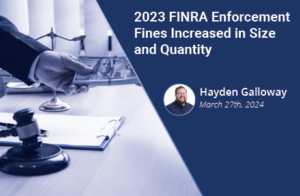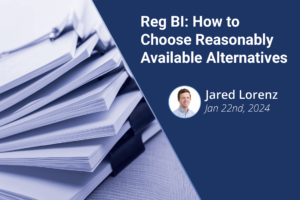January 22nd, 2024 | Connor Thomas, Vice President Of Business Development, CapitalROCK
When Reg BI was adopted by the SEC on June 5, 2019, the part that stuck out most for many people was the Obligation of Care, also described as the Care Component. Reg BI has four Obligations:
-
- Disclosure
-
- Care
- Conflict of Interest
- Compliance
Three of the four obligations, Disclosure, Conflicts of Interest, and Compliance are all very common regulatory words. In fact, I would go so far as to say that those three topics were the foundations of compliance programs across financial services. The Care Obligation was a new and unknown requirement that left many firms scratching their heads. Not that the other obligations didn’t have their challenges, but each was a topic not unfamiliar to broker-dealers. Many of the action items may have been inconvenient or uncomfortable, but the required changes were in many cases enhancements of existing processes and documentation.
What made the Care Component So Difficult?
Well, first of all, we know that there must have been some difficulty because the SEC published a Staff Bulletin about the Care Obligation on April 20, 2023, nearly 3 years after the Reg BI effective date. I suspect the SEC didn’t decide to spill a bunch of ink on this topic because broker-dealers were acing their Reg BI examinations. On the contrary, the Staff Bulletin (which you can find here) had 20 FAQ style questions and used more than 6,000 words in total. With the elapsed time between the Reg BI effective date and the Staff Bulletin on the Care Obligation, I would imagine that these questions were way more than just frequently asked. If you have gotten this far, I would encourage you to read the FAQ in its entirety. If I was challenged to describe the FAQ and its overarching theme in as few words as possible, I’d say something along the lines of “The FAQ is responding to questions about actions that may have been permissible under FINRA’s old Rule 2111, but that the SEC is saying are no longer permissible under Reg BI”. This is a vast understatement, however, I think it’s a helpful way to look at it. Before Reg BI, FINRA’s Rule 2111, known as the Suitability Rule, was a mature and well-known rule. Naturally, the firms operating under Reg BI wanted more clarity on the changes their firm would need to adopt to comply with Reg BI.
Rather than restate each of the FAQ’s, I’d like to highlight several of the topics that I saw most frequently from firms that were looking to improve their Reg BI exam readiness. For many reasons, which I will go through below, RightBRIDGE can help broker-dealers not only generally improve their compliance posture, but also create a more transparent process that is easier explained and demonstrated to a firm’s regulators. (Sidebar: You should watch what top broker-dealer executives are saying about their experience with their regulators and RightBRIDGE)
Before we get into the specific use cases from the SEC’s Staff Bulletin, it would be helpful to understand the basic framework for how RightBRIDGE works.
RightBRIDGE creates a systematized process for certain (or all depending upon the firm’s desire) recommendations and account fundings. The basic premise is that RightBRIDGE is built on a configurable set of rules that incorporates the licensing firm’s specific policies and procedures. In other words, RightBRIDGE provides a framework that can systematize many regulatory requirements.
Generally speaking, across all subjects and across all industries, if you didn’t document it, it didn’t happen. Or at least, you cannot prove that it happened. You’ll notice across many of these FAQ topics, documentation is the key. This is another strong suit of RightBRIDGE. RightBRIDGE can standardize the data collection and analysis process firmwide. Each report, which we sometimes refer to as “an artifact” is essentially a process documentation. Reports contain the questions asked, the answers provided by the client, and the status of the recommendation compared with the firm’s established best interest policies and procedures. Many RightBRIDGE customers also require a signature from the client. Each outcome, whether positive or negative, has automatically generated ReasonText™. ReasonText™ is plain English text that links the data in the case and the recommendation. ReasonText™ also explains the implications of the case data and specific attributes of the recommendation. As a basic example, let’s say that a customer, Bill, is considering rolling his 401k into an IRA. As we collected the case data, we found that Bill wanted professional advice for his portfolio. We also found that Bill’s 401k from his old employer was a self-service type plan. ReasonText™ would be able to compare Bill’s current circumstances in the plan, his preference for advice, and the selected account type’s professional advice offering. So ReasonText™ might say something like “Bill has separated from service with his old employer. Bill is looking for professional advice and money management and his old 401k does not provide this level of advice or service”. This is an example of just a single line of ReasonText™. Each recommendation comes complete with a page to a page and a half of ReasonText™. ReasonText™ is unbiased and simply explains how case data intersects with recommendations or features, benefits, or other factors related to the recommendation. ReasonText™ can also be supplemented by specific notes written by the financial professional. What this all boils down to is a process that collects required case data, including client preferences and goals, and creates a process that can determine and document whether the case data and the recommendation are consistent with the best practices and policies and procedures of the broker-dealer.
At a high level, certain requirements of Reg BI require that the financial professional act in a particular way and gather certain specified data. Without proper documentation, it’s hard to show compliance with this sort of requirement.
Now that we have laid the foundation for RightBRIDGE, let’s move to application. Listed below are a few of the FAQs where broker-dealers sought out RightBRIDGE for help.
FAQ #5 What is an “investment profile?” How does the investment profile help me satisfy my care obligation?
According to the response in the Staff Bulletin “The term “investment profile” refers to information that the firm or financial professional generally should make reasonable efforts to ascertain about the retail investor. Obtaining and then evaluating information about the retail investor’s investment profile is a critical step to satisfying your care obligation.” The bulletin goes on to list many data points that the staff believes that financial professionals should obtain and evaluate. This process is described as critical in satisfying the care obligation. For many firms systematizing this process was a challenge. In absence of a tool like RightBRIDGE, it’s exceedingly difficult to systematize a process with forms. Sure, you can collect data with a form, but this makes the analyzation process even more difficult. Does the analyzation process require concentration tests, or some other form of math? If so, this can lead to costly errors. Additionally, it’s very time intensive to have a human review process that checks for form completion. So far, the difficulty that I have described doesn’t take into account any sort of scale. Once you think about managing even a handful of financial professionals you can see how a process like this is very time intensive and can easily lead to failure points. Many broker-dealers that decided to license RightBRIDGE had this exact scenario in mind. They needed a systematized solution that dictated which data was collected, what was done with it, and what sort of documentation would be required for approval. The RightBRIDGE process is a natural fit for this sort of systemization.
FAQ #16 Should firms document the evaluation of reasonably available alternatives?
“Although there is no requirement of such documentation, in the staff’s view, it may be difficult for a firm to demonstrate compliance with its obligations to retail investors, or periodically assess the adequacy and effectiveness of its written policies and procedures, without documenting the basis for certain recommendations.”
In other words, if you didn’t document it, we have no way of knowing if you actually considered any reasonably available alternatives. The RightBRIDGE process gives financial professionals the type of data that they need in order to consider reasonably available alternatives. RightBRIDGE also provides logic that can match investments and recommendations against the firms’ requirements for reasonableness.
Bonus Material: When Reg BI first came out there was some debate about where firms should apply reasonably available alternatives. Should this be done at the account type level? The product type level? The specific product type (i.e.. Mutual funds versus other mutual funds)? Most firms initially decided to document alternatives at only one of those levels. After a few examinations, many firms came to the conclusion that the best practice is to document reasonably available alternatives at as many levels as possible. This is of course something that RightBRIDGE can help systematize and document.
FAQ #20 Part B: Do I need to consider whether a brokerage or advisory account is more appropriate for an investment or investment strategy when providing recommendation or advice to a retail investor of a dually licensed financial professional?
“Yes. Dually registered firms and dually licensed financial professionals have an obligation to reasonably believe the recommendation or advice they provide regarding account type is in the retail investor’s best interest.” The staff goes on to say that certain aspects such as the holding period and any associated costs should be taken into consideration. The RightBRIDGE Product Profiler is ideally suited for this sort of analysis. The customer’s time horizon, investment preferences, and investment profile are all compared with the features and benefits of each account type. One of the more popular pages in the RightBRIDGE report is the fee disclosure chart which clearly outlines account and product related fees.
Summary
These are just a few of the FAQ topics that seemed to drive the most interest in the RightBRIDGE platform. Ultimately, as with any regulation, documentation plays a key role. When balancing many overlapping regulatory requirements (state level requirements for example), having a systematized process that can streamline data collection, analysis, and documentation is a must. Included amongst the citations in this blog are a variety of great resources to further read up on this topic. If you are interested in learning more about RightBRIDGE, please reach out to us at [email protected]
Resources:
https://www.sec.gov/tm/standards-conduct-broker-dealers-and-investment-advisers#_ftn3
https://www.sec.gov/tm/faq-regulation-best-interest#care
https://www.investopedia.com/what-is-the-sec-s-regulation-bi-best-interest-rule-4689542
https://www.morganlewis.com/pubs/2012/05/finra-issues-additional-guidance-suitability-rule
The material contained in this communication is informational and general in nature. The material contained in this communication should not be relied upon or used without consulting appropriate legal or financial representatives to consider your specific circumstances. This communication was published on the date specified and may not include any changes in the topics, laws, rules, or regulations covered.






